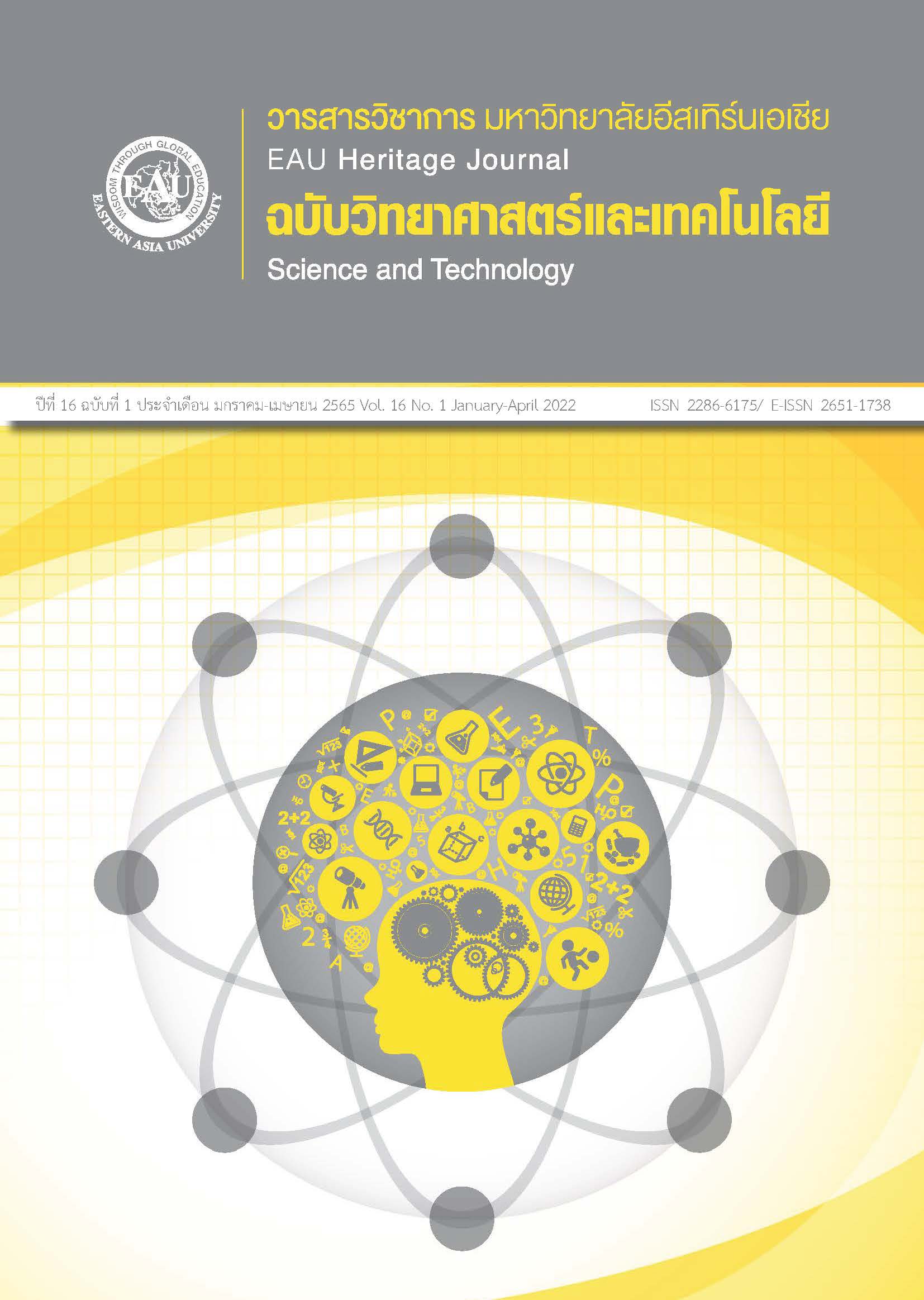ฤทธิ์ต้านเชื้อแบคทีเรียสแตฟฟิโลคอคคัส ออเรียส ของเครื่องเทศไทย ในผลิตภัณฑ์ละอองพ่นฝอย
คำสำคัญ:
ฤทธิ์ต้านแบคทีเรีย, เครื่องเทศไทย, สแตฟฟิโลคอคคัส ออเรียสบทคัดย่อ
สแตฟฟิโลคอคคัส ออเรียส (Staphylococcus aureus) เป็นแบคทีเรียแกรมบวกซึ่งพบเป็นปกติบนผิวหนังของมนุษย์และที่สำคัญแบคทีเรียชนิดนี้ยังสามารถก่อโรคจากสารพิษที่สร้างขึ้นในมนุษย์ได้ โดยเฉพาะโรคระบบทางเดินอาหารซึ่งเชื้อจะปนเปื้อนจากมือสู่อาหาร วัตถุประสงค์ของงานวิจัยเพื่อสร้างนวัตกรรมละอองพ่นฝอยจากเครื่องเทศของไทยที่สามารถยับยั้งการเจริญของเชื้อ สแตฟฟิโลคอคคัส ออเรียส บนมือได้ โดยการเก็บตัวอย่างเครื่องเทศของไทยจำนวน 10 ชนิด ได้แก่ กระชาย ขมิ้น พริก กระเทียม ตะไคร้ หัวหอม มะกรูด ขิง ข่า และพริกไทย การทดสอบพบว่าสารสกัดหยาบกระเทียม และใบมะกรูด มีประสิทธิภาพในการยับยั้งแบคทีเรีย สแตฟฟิโลคอคคัส ออเรียส สายพันธุ์ TISTR 1466 โดยมีขอบเขตการยับยั้ง 15 และ 10 มิลลิเมตร ตามลำดับ แอมพิซิลิน 10 ไมโครกรัม ถูกใช้เป็นตัวควบคุมเชิงบวก ส่วนน้ำกลั่นปราศจากเชื้อใช้เป็นตัวควบคุมเชิงลบ การทดสอบความเข้มข้นต่ำสุดที่สามารถยับยั้งการเจริญของเชื้อ สแตฟฟิโลคอคคัส ออเรียส ใช้วิธีการเจือจางในอาหารเลี้ยงเชื้อเหลวแบบหลายหลอด ค่าความเข้มข้นต่ำสุดที่สามารถยับยั้งการเจริญของเชื้อ สแตฟฟิโลคอคคัส ออเรียส ของสารสกัดหยาบจากกระเทียมและใบมะกรูด มีค่าเท่ากับ 12.5 และ 25 มิลลิกรัมต่อมิลลิลิตร การประเมินค่าความเข้มข้นต่ำสุดที่สามารถฆ่าเชื้อ สแตฟฟิโลคอคคัส ออเรียส ใช้เทคนิคการเกลี่ยเพลท โดยสังเกตจากเชื้อที่ไม่สามารถเจริญได้บนอาหารเลี้ยงเชื้อแข็ง ซึ่งมีค่าเท่ากันกับค่าความเข้มข้นต่ำสุดที่สามารถยับยั้งการเจริญของเชื้อได้ทั้งสารสกัดหยาบกระเทียมและใบมะกรูด สารสกัดจากเครื่องเทศของไทยทั้งสองชนิดมีประสิทธิภาพสามารถใช้เป็นทางเลือกเพื่อพัฒนาเป็นสเปรย์ยับยั้งการเจริญของเชื้อ สแตฟฟิโลคอคคัส ออเรียส บนมือได้
เอกสารอ้างอิง
Castro, A., Komora, N., Ferreira, V., Lira, A., Mota, M., Silva, J., & Teixeira, P. (2016). Prevalence of Staphylococcus aureus from nares and hands on health care professionals in a Portuguese Hospital. Journal of Applied Microbiology, 121(3), 831–839. https://doi.org/10.1111/jam.13186
Chansakaow, S., Leelapornpisid, P., Yosprasit, K., & Tharavichitkul, P. (2005). Antibacterial activity of Thai medicinal plant extracts on the skin infectious microorganisms. Acta horticulturae, 678, 153-157. https://doi.org/10.17660/ActaHortic.2005.678.21
Hongpattarakere, T., Chanthachum, S., & Chanthaphon, S. (2008). Antimicrobial activities of essential oils and crude extracts from tropical Citrus spp. against food-related microorganisms. Songklanakarin Journal of Science and Technology (SJST), 30, 125-131. (in Thai)
Espadale, E., Pinchbeck, G., Williams, N. J., Timofte, D., McIntyre, K. M., & Schmidt, V. M. (2018). Are the hands of veterinary staff a reservoir for antimicrobial-resistant bacteria? a randomized study to evaluate two hand hygiene rubs in a veterinary hospital. Microbial Drug Resistance. 24(10), 1607-1616. doi: 10.1089/mdr.2018.01831607
Fahim, A., Himratul-Aznita, W. H., & Abdul-Rahman, P. S. (2020). Allium-sativum and bakuchiol combination: A natural alternative to Chlorhexidine for oral infections?. Pakistan journal of Medical Sciences, 36(2), 271–275. https://doi.org/10.12669/pjms.36.2.1457
Ferreira, C., Costa, S. S., Serrano, M., Oliveira, K., Trigueiro, G., Pomba, C., & Couto, I. (2021). Clonal lineages, antimicrobial resistance, and pvl carriage of staphylococcus aureus associated to skin and soft-tissue infections from ambulatory patients in Portugal. Antibiotics, 10(4), 345. https://doi.org/10.3390/antibiotics10040345
Genc, O., & Arikan, I. (2020). The relationship between hand hygiene practices and nasal Staphylococcus aureus carriage in healthcare workers. La Medicina del lavoro, 111(1), 54–62. https://doi.org/10.23749/mdl.v111i1.8918
Marasini, B. P., Baral, P., Aryal, P., Ghimire, K. R., Neupane, S., Dahal, N., Singh, A., Ghimire, L., & Shrestha, K. (2015). Evaluation of antibacterial activity of some traditionally used medicinal plants against human pathogenic bacteria. BioMed Research International, 2015, 265425. https://doi.org/10.1155/2015/265425
Mongkoltrirat, S., Kerdchoechuen, O., & Laohakunjit, N. (2013). Antioxidant activity of garlic and onion extracts. Agricultural Science Journal, 44(2), 585-588. (in Thai)
Mozaffari Nejad, A. S., Shabani, S., Bayat, M., & Hosseini, S. E. (2014). Antibacterial effect of garlic aqueous extract on Staphylococcus aureus in Hamburger. Jundishapur Journal of Microbiology, 7(11), e13134. https://doi.org/10.5812/jjm.13134
Phaiboon, N., Pulbutr, P., Sungthong, B., & Rattanakiat, S. (2019). Effects of the ethanolic extracts of Guava Leaves, Licorice Roots and Cloves on the Cariogenic Properties of Streptococcus mutans. Pharmacognosy Journal, 11(5), 1029-1036. doi:10.5530/pj.2019.11.162
Ratthawongjirakul, P., & Thongkerd, V. (2015). Fresh garlic extract inhibits Staphylococcus aureus biofilm formation under chemopreventive and chemotherapeutic conditions. Songklanakarin Journal of Science and Technol, 38(4), 381-389. (in Thai)
Sajjad, W., Sohail, M., Ali, B., Haq, A., Din, G., Hayat, M., Khan, I., Ahmad, M., & Khan, S. (2015). Antibacterial activity of Punica granatum peel extract. Mycopath, 13(2), 105-111. https://bit.ly/3u9AL3y
Sreepian, A., Sreepian, P. M., Chanthong, C., Mingkhwancheep, T., & Prathit, P. (2019). Antibacterial activity of essential oil extracted from Citrus hystrix (Kaffir Lime) peels: An in vitro study. Tropical Biomedicine, 36(2), 531–541. https://www.msptm.org/files/Vol36No2/531-541-Sreepian-A.pdf.
Tong, S. Y., Davis, J. S., Eichenberger, E., Holland, T. L., & Fowler, V. G., Jr (2015). Staphylococcus aureus infections: Epidemiology, pathophysiology, clinical manifestations, and management. Clinical Microbiology Reviews, 28(3), 603–661. https://doi.org/10.1128/CMR.00134-14







